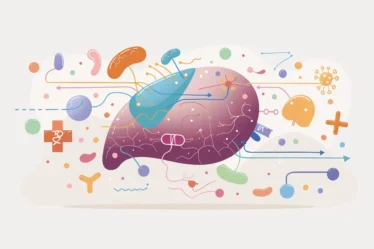
Bacteriophages, or phages, are viruses that specifically infect bacteria.
Unlike other viruses, they are specialized to recognize and enter bacterial cells. Once inside, they use the bacteria’s machinery to replicate. Bacteriophages have two life cycles: the lytic cycle, where they reproduce and cause the bacteria to burst, and the lysogenic cycle, where they integrate their DNA into the bacterial genome and stay dormant until conditions change.
These unique cycles allow bacteriophages to control bacterial populations and influence bacterial evolution.
Essentials of Bacteriophages
Are you short on time? Here’s a quick recap of what a bacteriophage is:
🟠 Bacteriophages are viruses that specifically infect bacteria, using them to replicate and spread.
🟠 In the lytic cycle, bacteriophages replicate rapidly, destroying the bacterial cell as new viruses are produced and released.
🟠 In the lysogenic cycle, bacteriophage DNA integrates into the bacterial genome, lying dormant until triggered to enter the lytic cycle.
🟠 Bacteriophage M13 is a filamentous phage used in molecular cloning and phage display due to its unique structure and non-destructive infection process.
🟠 Bacteriophage Lambda can switch between the lytic and lysogenic cycles, making it valuable for studying gene regulation and virus-host interactions.
🟠 Bacteriophages select their host based on specific receptors on bacterial surfaces, determining which bacteria they can infect.
🟠 Bacteriophage DNA hijacks bacterial machinery to replicate itself, often destroying the bacterial cell as new viruses are produced.
Do you need help with the lytic and lysogenic cycle of a bacteriophage? That’s okay! Personalized tutoring or interactive biology classes can help you understand these topics better. Explore more biology topics and expand your knowledge with our free Biology blogs.
Structure and Life Cycle of Bacteriophages
Bacteriophages have a unique structure that enables them to infect bacteria. Understanding their structure helps explain how they can attach to bacterial cells and inject their genetic material.
Additionally, bacteriophages have two main life cycles: the lytic cycle, in which they quickly replicate and destroy their host, and the lysogenic cycle, in which they integrate into the host’s DNA and remain dormant until conditions are right for activation.
Bacteriophage Structure
Bacteriophages have a simple yet effective structure that includes a protein coat called a capsid, which encases their genetic material, usually DNA or RNA. Attached to the capsid is a tail structure, which may have fibers that help the phage recognize and bind to specific receptors on the surface of a bacterial cell.
Once attached, the tail contracts to inject the phage’s genetic material into the bacterium. This highly specialized process allows the bacteriophage to hijack the bacterial cell’s machinery, leading to viral replication.
The Lytic Cycle: How Bacteriophages Replicate and Destroy Bacteria
The lytic cycle is a rapid and destructive process where bacteriophages take over a bacterial cell to reproduce.
The lytic cycle begins when the phage attaches to the host bacteria and injects its DNA into the cell. The phage DNA then controls the bacterial machinery, directing it to produce new phage components instead of its cellular functions.
As the bacterial cell is filled with new phages, it eventually bursts or lyses, releasing the newly formed bacteriophages to infect other bacteria.
This cycle of viral replication and cell destruction allows bacteriophages to spread quickly within a bacterial population.
The Lysogenic Cycle: Integration and Dormancy
In the lysogenic cycle, bacteriophages take a more subtle approach. Instead of immediately replicating and destroying the host cell, the phage DNA integrates into the bacterial genome, becoming a part of the host’s DNA.
This integrated DNA, known as a prophage, remains dormant within the host cell, allowing the bacterium to function normally.
However, the lysogenic cycle can switch to the lytic cycle if certain environmental triggers, such as stress or UV light, occur. When this happens, the prophage is activated, and the viral DNA begins to replicate, eventually destroying the host cell as it enters the lytic cycle.
Comparison of Lytic and Lysogenic Cycles
| Feature | Lytic Cycle | Lysogenic Cycle |
| Outcome for Bacteria | Bacteria is destroyed (lysed) | Bacteria remain alive |
| Phage DNA Integration | Does not integrate into bacterial DNA | Integrates into bacterial DNA (prophage) |
| Replication | Rapid production of new phages | Phage DNA replicates with bacterial DNA |
| Trigger for Activation | Immediate after infection | Can remain dormant, triggered by stress |
Are you curious about evolution? Darwin’s theory of natural selection explains how species evolve based on traits that help them survive and reproduce.
Characteristics of Specific Bacteriophages
Bacteriophages come in various forms, each with unique features that make them valuable in scientific research. This section will explore two well-known bacteriophages: M13 and Lambda. These phages are widely used in studies because of their distinct structures and life cycles.
Bacteriophage M13: Characteristics and Uses
Bacteriophage M13 has a unique filamentous shape, unlike the more common icosahedral (20-sided) phages. M13 infects bacteria without killing them, which sets it apart from many other phages that typically destroy their host cells during replication.
M13 carries single-stranded DNA and is often used in molecular cloning and phage display techniques. Phage display allows scientists to study how proteins interact, develop new antibodies, and create potential treatments.
Key Characteristics of Bacteriophage M13
- Filamentous Shape: M13 has a long, thread-like structure, different from many other phages.
- Non-Lytic: Unlike other phages, M13 doesn’t kill its host but allows continuous phage production.
- Research Applications: Widely used in molecular cloning and phage display to study protein interactions.
Bacteriophage Lambda: A Closer Look
Bacteriophage Lambda is another important phage in molecular biology. It is known for its double-stranded DNA and the ability to switch between the lytic and lysogenic cycles.
Structurally, Lambda has an icosahedral head and a tail that it uses to inject its DNA into the bacterial host. In the lytic cycle, Lambda quickly replicates and destroys the host cell, releasing new phages.
In the lysogenic cycle, Lambda integrates its DNA into the host’s genome, where it can remain dormant until conditions trigger its reactivation.
This ability to switch between life cycles has made Lambda a key model in studying gene regulation and the interactions between viruses and their hosts. Lambda is also widely used in cloning and gene expression research.
Key Characteristics of Bacteriophage Lambda
- Icosahedral Head: Lambda has a head-tail structure typical of many phages.
- Dual Life Cycles: Lambda can switch between lytic and lysogenic cycles, offering flexibility in its replication.
- Genetic Research: Lambda is vital in studying gene regulation due to its ability to integrate into bacterial DNA.
Why should you study microbiology? Find out what you’ll be learning.
Behavior and Interactions of Bacteriophages
Bacteriophages interact with bacteria in highly specific ways, determining which bacteria they can infect and hijacking the host’s cellular machinery for their replication.
How Bacteriophages Select Their Host
Bacteriophages are highly selective about their bacterial hosts. They recognize and bind to specific receptors on bacteria’s surfaces, often proteins or sugars unique to certain species or strains.
This precise binding process means that a phage can infect only bacteria with the right receptors. The specificity of this interaction determines the phage’s host range or the variety of bacterial types it can infect. Factors such as the structure of the receptor and the presence of any blocking molecules on the bacterial surface influence whether a phage can successfully attach to and infect a bacterium.
Bacteriophage DNA: How It Hijacks Bacterial Machinery
Once a bacteriophage successfully injects its DNA into a bacterial cell, it quickly takes control of the cell’s machinery.
The phage DNA directs the bacterial enzymes and ribosomes to stop the bacterium’s normal functions and instead start producing viral components.
Different bacteriophages use various strategies to achieve this takeover. Some phages degrade the bacterial DNA to eliminate competition, while others simply suppress bacterial genes to prioritize their replication.
The bacterial cell is turned into a virus factory, producing new phage particles until it bursts open, releasing the newly formed viruses to infect more bacteria.
This hijacking process is highly efficient, ensuring the phage can produce as many copies of itself as possible before destroying the bacterial cell.
Have you ever heard of mimicry in biology? See what it’s all about.
Bacteriophage Therapy and Its Potential
Bacteriophage therapy is a promising approach to treating bacterial infections, especially antibiotic-resistant ones.
This therapy uses bacteriophages, viruses that specifically infect and kill bacteria. Unlike broad-spectrum antibiotics, phage therapy targets specific bacteria, leaving beneficial bacteria unharmed. This precision makes phage therapy an attractive option, particularly as antibiotic resistance becomes a bigger problem.
While phage therapy has shown success in some cases, there are challenges to overcome, such as finding the right phage for each infection and understanding how bacteria might develop resistance to phages.
Researchers are working to improve phage therapy and explore its potential as an alternative to traditional antibiotics, hoping that it could become a vital tool in fighting stubborn bacterial infections.
What is the difference between prokaryotes and eukaryotes?
Final Thoughts on Bacteriophage Structure and Life Cycles
This guide taught us about bacteriophages and how they use the lytic and lysogenic cycles to infect bacteria. We also looked at specific phages like M13 and Lambda and their roles in research and bacterial infection.
If you want to get even better at this, consider working with a tutor who can guide you. Private teachers can offer one-on-one lessons that fit your needs. Whether in regular classes or if you need extra tutoring, having a tutor to help with bacteriophages can boost your understanding.
If you’re looking for a biology tutor, try searching for “biology tutor Liverpool” or “biology teacher London” on a platform like meet’n’learn. This can help you find the perfect private teacher for your needs.
If you prefer learning in a group, search for “biology classes Leeds” or “biology lessons Birmingham” online. You’ll find options at community colleges or educational workshops.
FAQs on Bacteriophages
1. What is a bacteriophage?
A bacteriophage is a virus that targets and infects bacteria to replicate.
2. How does bacteriophage M13 stand out from other phages?
Bacteriophage M13 is unique because it has a filamentous shape and doesn’t kill its host, making it useful in labs for cloning and studying proteins.
3. Why is bacteriophage lambda important in genetic research?
Bacteriophage lambda is valuable for studying how genes are controlled because it can switch between active and dormant stages.
4. How do bacteriophages find the right bacteria to infect?
Bacteriophages find their bacterial hosts by locking onto specific receptors on the surface of the bacteria.
5. What happens to bacteria during the lytic cycle of a bacteriophage?
In the lytic cycle, the bacteriophage takes over the bacteria’s machinery to make new viruses, eventually causing the bacteria to burst.
6. What is the lysogenic cycle in bacteriophages?
In the lysogenic cycle, the bacteriophage DNA becomes part of the bacterial DNA and stays hidden until it becomes active again.
7. How do bacteriophages impact bacterial populations?
Bacteriophages can reduce bacterial populations by infecting and destroying specific bacteria through the lytic cycle.
8. Can bacteriophages be used to fight bacterial infections?
Yes, phage therapy uses bacteriophages to attack and kill antibiotic-resistant bacteria, offering a new way to treat infections.
References:
1. Wikipedia
2. Britannica
3. NIH



